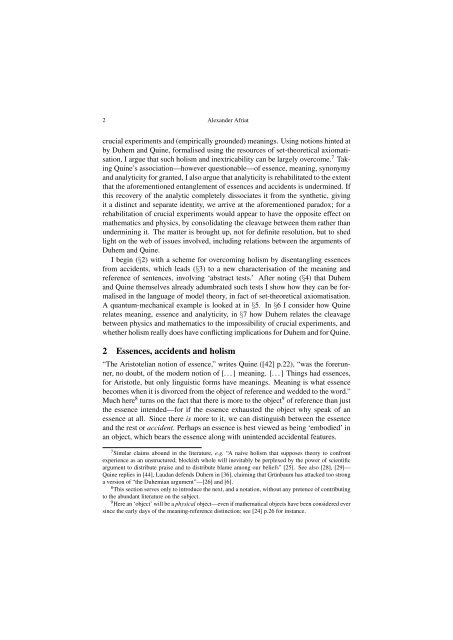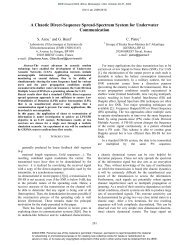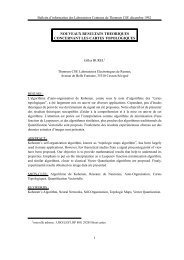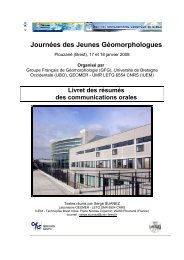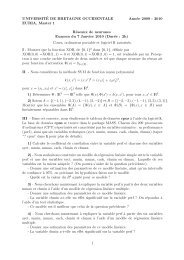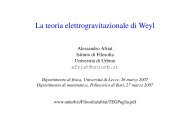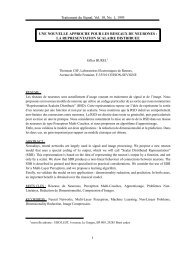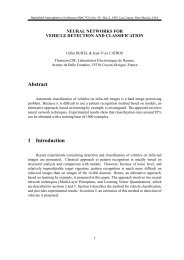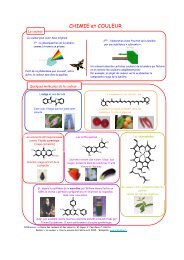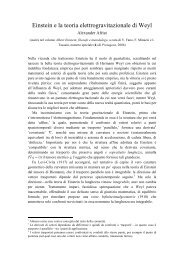Duhem, Quine and the other dogma
Duhem, Quine and the other dogma
Duhem, Quine and the other dogma
- No tags were found...
You also want an ePaper? Increase the reach of your titles
YUMPU automatically turns print PDFs into web optimized ePapers that Google loves.
2 Alex<strong>and</strong>er Afriat<br />
crucial experiments <strong>and</strong> (empirically grounded) meanings. Using notions hinted at<br />
by <strong>Duhem</strong> <strong>and</strong> <strong>Quine</strong>, formalised using <strong>the</strong> resources of set-<strong>the</strong>oretical axiomatisation,<br />
I argue that such holism <strong>and</strong> inextricability can be largely overcome. 7 Taking<br />
<strong>Quine</strong>’s association—however questionable—of essence, meaning, synonymy<br />
<strong>and</strong> analyticity for granted, I also argue that analyticity is rehabilitated to <strong>the</strong> extent<br />
that <strong>the</strong> aforementioned entanglement of essences <strong>and</strong> accidents is undermined. If<br />
this recovery of <strong>the</strong> analytic completely dissociates it from <strong>the</strong> syn<strong>the</strong>tic, giving<br />
it a distinct <strong>and</strong> separate identity, we arrive at <strong>the</strong> aforementioned paradox; for a<br />
rehabilitation of crucial experiments would appear to have <strong>the</strong> opposite effect on<br />
ma<strong>the</strong>matics <strong>and</strong> physics, by consolidating <strong>the</strong> cleavage between <strong>the</strong>m ra<strong>the</strong>r than<br />
undermining it. The matter is brought up, not for definite resolution, but to shed<br />
light on <strong>the</strong> web of issues involved, including relations between <strong>the</strong> arguments of<br />
<strong>Duhem</strong> <strong>and</strong> <strong>Quine</strong>.<br />
I begin (§2) with a scheme for overcoming holism by disentangling essences<br />
from accidents, which leads (§3) to a new characterisation of <strong>the</strong> meaning <strong>and</strong><br />
reference of sentences, involving ‘abstract tests.’ After noting (§4) that <strong>Duhem</strong><br />
<strong>and</strong> <strong>Quine</strong> <strong>the</strong>mselves already adumbrated such tests I show how <strong>the</strong>y can be formalised<br />
in <strong>the</strong> language of model <strong>the</strong>ory, in fact of set-<strong>the</strong>oretical axiomatisation.<br />
A quantum-mechanical example is looked at in §5. In §6 I consider how <strong>Quine</strong><br />
relates meaning, essence <strong>and</strong> analyticity, in §7 how <strong>Duhem</strong> relates <strong>the</strong> cleavage<br />
between physics <strong>and</strong> ma<strong>the</strong>matics to <strong>the</strong> impossibility of crucial experiments, <strong>and</strong><br />
whe<strong>the</strong>r holism really does have conflicting implications for <strong>Duhem</strong> <strong>and</strong> for <strong>Quine</strong>.<br />
2 Essences, accidents <strong>and</strong> holism<br />
“The Aristotelian notion of essence,” writes <strong>Quine</strong> ([42] p.22), “was <strong>the</strong> forerunner,<br />
no doubt, of <strong>the</strong> modern notion of [. . . ] meaning. [. . . ] Things had essences,<br />
for Aristotle, but only linguistic forms have meanings. Meaning is what essence<br />
becomes when it is divorced from <strong>the</strong> object of reference <strong>and</strong> wedded to <strong>the</strong> word.”<br />
Much here 8 turns on <strong>the</strong> fact that <strong>the</strong>re is more to <strong>the</strong> object 9 of reference than just<br />
<strong>the</strong> essence intended—for if <strong>the</strong> essence exhausted <strong>the</strong> object why speak of an<br />
essence at all. Since <strong>the</strong>re is more to it, we can distinguish between <strong>the</strong> essence<br />
<strong>and</strong> <strong>the</strong> rest or accident. Perhaps an essence is best viewed as being ‘embodied’ in<br />
an object, which bears <strong>the</strong> essence along with unintended accidental features.<br />
7 Similar claims abound in <strong>the</strong> literature, e.g. “A naive holism that supposes <strong>the</strong>ory to confront<br />
experience as an unstructured, blockish whole will inevitably be perplexed by <strong>the</strong> power of scientific<br />
argument to distribute praise <strong>and</strong> to distribute blame among our beliefs” [25]. See also [28], [29]—<br />
<strong>Quine</strong> replies in [44], Laudan defends <strong>Duhem</strong> in [36], claiming that Grünbaum has attacked too strong<br />
a version of “<strong>the</strong> <strong>Duhem</strong>ian argument”—[26] <strong>and</strong> [6].<br />
8 This section serves only to introduce <strong>the</strong> next, <strong>and</strong> a notation, without any pretence of contributing<br />
to <strong>the</strong> abundant literature on <strong>the</strong> subject.<br />
9 Here an ‘object’ will be a physical object—even if ma<strong>the</strong>matical objects have been considered ever<br />
since <strong>the</strong> early days of <strong>the</strong> meaning-reference distinction; see [24] p.26 for instance.


